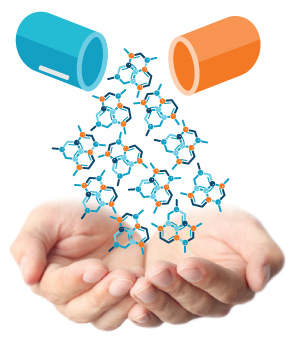Pharmacokinetic Clinical Studies: Improving People’s Lives
 The biological significance of metals from both pharmaceutical drug discovery and production aspects has increased significantly over the past two decades. Integration of trace metals in complex pharmaceuticals, both small and large molecule, can play a key role in their viability as well as their stability. Furthermore, active sites on organic molecules will dictate their adsorptive properties (“stickiness” to the outside of the molecule) for trace metals, which can also impact clinical efficacy. Brooks Applied Labs has a long history of supporting both the prevention and cure for cancers and other human ailments through research, consulting, and analytical services.
The biological significance of metals from both pharmaceutical drug discovery and production aspects has increased significantly over the past two decades. Integration of trace metals in complex pharmaceuticals, both small and large molecule, can play a key role in their viability as well as their stability. Furthermore, active sites on organic molecules will dictate their adsorptive properties (“stickiness” to the outside of the molecule) for trace metals, which can also impact clinical efficacy. Brooks Applied Labs has a long history of supporting both the prevention and cure for cancers and other human ailments through research, consulting, and analytical services.
Pharmaceutical companies, academic institutions, and international scientific consortiums have relied upon Brooks Applied Labs to deliver high quality, defensible analytical results for drug discovery, delivery, production, stability, and efficacy. Our proprietary methods target total elemental composition of materials, as well as their molecular forms, using advanced analytical equipment (such as ICP-MS/MS) coupled to chromatographic systems. A short list of web links has been provided below, representing just a few of our collaborative efforts.
One of the highlights of our efforts has been working with a consortium of concerned scientists to address the arsenicosis issue that affects the inhabitants in Bangladesh. It has been well documented that the drinking water sources for rural areas in Bangladesh contain very high concentrations of arsenic. Certain molecular forms of selenium were identified to chemically interact with arsenic in the human body to produce a selenium-arsenic adduct that is more readily excreted in the urine; thus, reducing the carcinogenic effects. BAL continues to support research efforts to alleviate the impacts of arsenicosis throughout the world.
Quality control and conformance to regulatory requirements are of utmost importance in establishing defensibility and maximizing confidence in all results released by BAL. Furthermore, BAL takes it one step further with conformance to scientific principles which can contradict promulgated methods and publications. We are on the forefront of technology for analytical chemistry and applied metalloid research, as we take it upon ourselves to better scientific principles and educate those in need through webinars, presentation at scientific conferences, and workshops.
Our preventative efforts to combat cancer and other ailments have been in the form of testing the environment around all of us on a relatively holistic basis. BAL’s partnership with the food, environmental, power generation, petroleum processing, mining, and other markets have mitigated exposure to trace metals and metalloid compounds internationally. By understanding not just how much of an element is present in a material, but also the molecular form, the risk assessment and remediation efforts are more focused and efficient. Our proprietary methods provide the technological advancements that make our air, water, soil, food, and products safer for the current and coming generations.
Whether your goal is to reduce or eliminate the risk of health concerns associated with metals and metalloid compounds before exposure to humans, or to treat ailments after manifestation, Brooks Applied Labs is excited to partner with you. Partnering with BAL goes beyond selecting a laboratory, as we are most often perceived as a valuable teammate called upon to solve the most challenging problems. Contact us to find out how we can help you with your next clinical or pharmacokinetic study.
https://clinicaltrials.gov/ct2/show/NCT02377635
https://gsa.confex.com/gsa/2014AM/webprogram/Paper250076.html
https://gsa.confex.com/gsa/2008AM/finalprogram/abstract_149365.htm
http://pubs.rsc.org/en/content/articlelanding/2017/mt/c7mt00201g#!divAbstract
https://pqdtopen.proquest.com/doc/894949380.html?FMT=ABS
https://www.ncbi.nlm.nih.gov/pmc/articles/PMC3705316/

Jan 18
Need the contact person with Brooks for cancer and other medical testing.
R Horsak